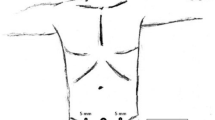Abstract
Purpose
To evaluate prospectively the feasibility and the duration of the plication of both aponeurosis through a totally endoscopic approach to the diastasis recti associated with midline hernias, correcting both pathologies simultaneously and objectively looking at their advantages and complications.
Methods
The prospective cohort study included patients suffering from midline hernias equal to or bigger than 2 cm size and associated diastasis recti, from April 2011 to October 2012. Full endoscopic subcutaneous approach is used to perform the surgery. An ultrasound scan was carried out to identify inter-rectus distances and recurrences in xiphoid, 3 cm supraumbilical and 2 cm subumbilical locations.
Results
A total of 21 patients were included in the study, with a mean follow-up of 20 months. The main complication was seroma. A significant reduction in the average distance between the rectus muscles was shown before surgery and at 1 month postoperative measures in all three locations (p < 0.001). No significant differences between the measured distances to the first and second year. A significant improvement at first postoperative year in cosmetic outcome compared with preoperative cosmetic condition (p < 0.001) was confirmed. Back pain improves significantly when diastasis recti is surgically corrected.
Conclusions
Totally endoscopic approach to diastasis recti associated with midline hernias is a feasible and reproducible method. It brings considerable esthetic advantages. Diastasis or hernia recurrences in medium term follow-up have not been observed. Diastasis greater than 6–7 cm or associated with severe musculoaponeurotic laxity of the abdominal wall could benefit from the use of reinforced prosthesis.













Similar content being viewed by others
References
Pitanguy I (1967) Abdominoplastias. Hospital 71(6):1541–1556
Ramirez OM (2000) Abdominoplasty and abdominal wall rehabilitation: a comprehensive approach. Plast Reconstr Surg 105:425–435
Huguier V (2012) Laparoscopic coupled with classical abdominoplasty in 10 cases of large rectus diastasis. Annales de chirugie plastique esthétique 57:350–355
Champault G (1998) Video-parieoscopic surgery of the abdominal wall. A study of 15 cases. Chirurgie 123(5):474–477
Eaves F (1996) Endoscopic abdominoplasty and endoscopically assisted miniabdominoplasty. Clin Plast Surg 23:599
Lockwood T (1998) Rectus muscle diastasis in males: primary indication for endoscopically assisted abdominoplasty. Plast Reconstr Surg 101(6):1685–1691
Nahas FX, Ferreira LM, Augusto SM, Ghelfond C (2005) Long-term follow-up of correction of rectus diastasis. Plast Reconstr Surg 115:1736–1741
Mendes Dde A, Nahas FX, Veiga DF et al (2007) Ultrasonography formeasuring rectus abdominis muscles diastasis. Acta Cir Bras 22:182–186
Rath AM, Attali P, Dumas JL, Goldlust D, Zhang J, Chevrel JP (1996) The abdominal linea alba: an anatomo-radiologic and biomechanical study. Surg Radiol Anat 18:281–288
Beer GM, Schuster A, Seifert B, Manestar M, Mihic-Probst DA, Weber SA (2009) The normal width of the linea alba in nulliparous women. Clin Anat 22:706–711
Yousif NJ, Lifchez SD, Nguyen HH (2004) Transverse rectus sheath plication in abdominoplasty. Plast Reconstr Surg 114:778
Van Uchelen JH, Kon M, Werker PM (2001) The long-term durability of plication of the anterior rectus sheath assessed by ultrasonography. Plast Reconstr Surg 107:1578–1584
Tadiparthi S, Shokrollahi K, Doyle GS, Fah FS (2012) Rectus sheath plication in abdominoplasty: assessment of its longevity and a review of the literatura. J Plast Reconstr Aesthet Surg 65:328–332
Mestak O et al (2012) Evaluation of the long-term stability of sheath plication using absorbable sutures in 51 patients with diastasis of the recti muscles: an ultrasonographic study. Plast Reconstr Surg 130(5):714–719
Rosen A (2011) Repair of the midline fascial defect in abdominoplasty with long-acting barbed and smooth absorbable sutures. Aesthetic Surg J 31(6):668–673
Al-Qattan M (1997) Abdominoplasty in multiparous women with severe musculoaponeurotic laxity. Br J Plast Surg 50:450–455
Acknowledgments
There is no financial support for this study by any organization or company.
Conflict of interest
JABL declares no conflict of interest.
ABL declares no conflict of interest.
JV declares no conflict of interest.
JMSG declares no conflict of interest.
JGM declares no conflict of interest.
JGM declares no conflict of interest.
JGJ declares no conflict of interest.
Author information
Authors and Affiliations
Corresponding author
Electronic supplementary material
Below is the link to the electronic supplementary material.
Supplementary material 1 (MPG 10972 kb)
Supplementary material 2 (MPG 29564 kb)
Rights and permissions
About this article
Cite this article
Bellido Luque, J., Bellido Luque, A., Valdivia, J. et al. Totally endoscopic surgery on diastasis recti associated with midline hernias. The advantages of a minimally invasive approach. Prospective cohort study. Hernia 19, 493–501 (2015). https://doi.org/10.1007/s10029-014-1300-2
Received:
Accepted:
Published:
Issue Date:
DOI: https://doi.org/10.1007/s10029-014-1300-2




